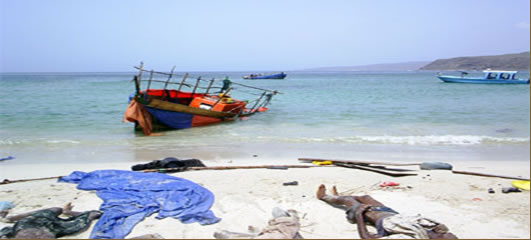Imagine that you are now in a boat, in the Gulf of Aden, destined to Yemen but the boat’s engine failed a week ago. You are experiencing extreme thirstiness, hungry and tiredness. Some passengers are no longer able to bear the thirst and choosing to jump into the sea. Dead bodies are thrown over board. Some passengers became crazy and started biting. You have taken this high risk voyage running away from your own country [Somalia] due to political instability and extreme poverty. Who do you blame? Yourself? Traffickers? Those who made your country a failed state?
This is neither an idle assumption nor a description of hypothetical situation. This was a reality for a group of Somalis who recently died in Yemen and many refugees before them. The political instability and poverty that Somalia has become notoriously famous since the civil war broke out force many Somalis to flee from their own country. A report produced by the U.S. Committee for Refugees noted, “Those [Somalis] who reached Yemen during the year [2002] crossed the Gulf of Aden in often-perilous journeys that reportedly cost several hundred refugees their lives when their makeshift boats sank.”
Before we examine the underlying factors that lead Somalis to seek safety and better life, let us quickly look at how Somalis are scattered in different parts of Africa and Arab countries. According to World Refugee Survey 2003 Country Report, it was estimated at the end of 2002, about 300,000 refugees and asylum seekers from Somalia lived in several countries. 140,000 of those were in Kenya, nearly 80,000 were in Yemen, an other 21,000 lived in Djibouti, about 20,000 were in Ethiopia, some 7,000 were in South Africa, about 7,000 were present in Egypt, more than 3,000 stayed in Tanzania, some 3,000 in Libya, more than 2,000 in Eritrea, about 1,000 in Uganda.
Besides those who left Somalia, there are hundreds of thousands of internally displaced people. The Global IDP Project of the Norwegian Refugee Council observed, “At the end of 2002, an estimated 350,000 Somalis are internally displaced people, most of them are women and children.”
Let us now look into briefly why so many Somalis take high risk voyages using smugglers to cross the Gulf of Aden. Somalia has been without a proper government since the civil war broke out in 1990. As result of that it has experienced a bitter political calamity and insecurity, which debilitated the country, stifled its economy, and disrupted its public and private sectors. Armed conflict is the highest factor that forces people to seek refuge. Project Ploughshares' Armed Conflicts Report said, “In 2000, independent media reports estimate that close to 400,000 Somali lives have been lost due to armed conflict since the civil war started”.
Several attempts to reconcile the warring Somali factions had failed. The outcome of the last national reconciliation conference held in Kenya is gasping for air now and it looks that it is going to follow the same trajectory as its predecessors. The war on terror has not helped Somali circumstance as the fight against terrorism is interpreted differently. As a result, Somalia is the longest running instance of state collapse in the history of Africa.
Political instability cannot be divorced from economic meltdown which normally results widespread poverty. The Socio-Economic Survey 2002 produced by the UNDP revealed, “Unemployment rates amount to 47.4 percent for the country. Per capita income of $226, The proportion of population living in extreme poverty is estimated as 43.2 percent for Somalia. General poverty estimates based on the number of people living on $2 per day are 73.4 percent for Somalia, According to this measure, 5 million people in Somalia live in poverty.”
Words are not enough to reflect the chaos, hunger and difficulties that Somalia has become notorious over the last few years. Another report published by the UNDP in 2002 depicts the poignant realities in the country, “… in Somalia, life expectancy is 47 years, almost one out four children dies before the age of five, and less than a third of Somalis have access to health services. Only one out of every five Somalis can write and read, and only 14 percent of children are enrolled in primary schools. More than three-quarters of the Somali population has no access to clean water, and almost half of them have no access to sanitation”.
It is depressing to see how a country that has physical resource endowment been turned upside down and its people forced to take horrific voyages that often end up in tragedy. Husayn Haji Ahmad, the acting Somali Consul-General in Aden, once said, “There is no paradise here. They [refugees] will not find a better life, only death at sea and broken dreams.” Somali politicians, who should have reintroduced political stability and pursued wealth creating opportunities, are either chasing dismissible foreign aid or sucking the blood of hard pressed people.
